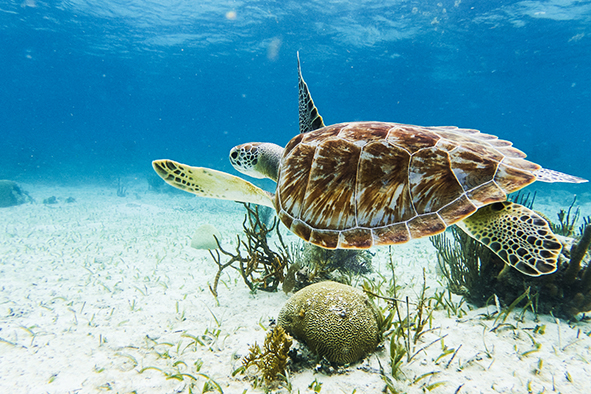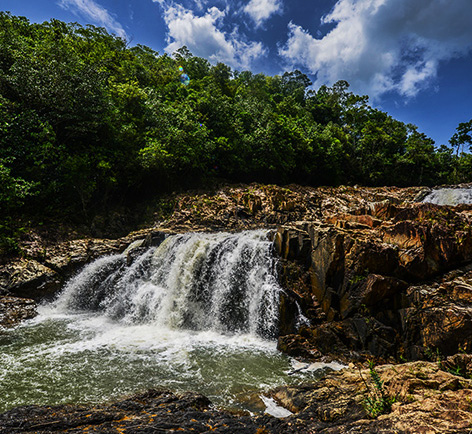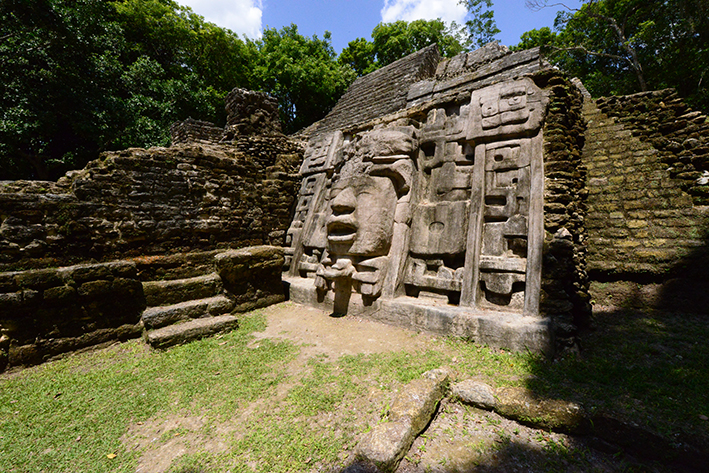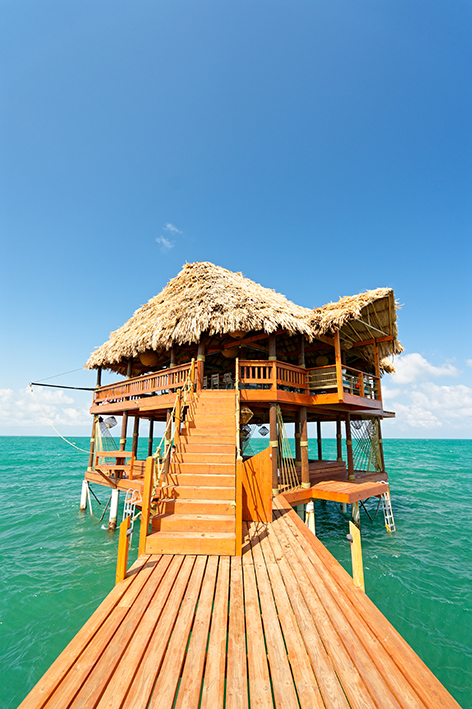I tread lightly along a root-tangled trail, deeper into the Central American jungle. Towering mahogany, cedar and ceiba trees, embraced by lianas, stand sentinel along the path, their branches weaving a net in the canopy above, filtering the moonlight and allowing flashes of silver starlight to slip through.
Ahead, my guide Mario waves his torch from side to side, scouring the dense rainforest for signs of life. Vast webs illuminate, and orb-weaver spiders hang in suspended animation, while giant mantises eye us curiously, and leaf-cutter ants march at our feet, working industriously beyond bedtime. But here in the Cockscomb Basin Wildlife Sanctuary of South-Central Belize, it’s a far bigger beast that we seek.



“Come on, jump!” says an encouraging voice from the water below. I gingerly position my legs over the side of the boat and look down. Beneath my feet, shimmering stars illuminate the water like a marine Milky Way, but these aren’t reflections of the night sky above: this is one of the world’s rare bioluminescent lagoons, and the neon nebulae are shining from within.
A short drive from The Lodge at Jaguar Reef – a lovely, laid-back resort on the sweeping, palm-fringed sands of Hopkins Beach – Belize’s Anderson Lagoon is one of just a handful of magical locations where bioluminescence lights up the ocean.

Best seen between October and March on a moonless night, this natural phenomenon occurs when the perfect combination of fresh and salt water, temperature and depth align. Tiny plankton called dinoflagellates gather, and a chemical reaction produces quick-fire flashes of blue-green light when they’re disturbed. With millions of these microorganisms in the lagoon and no nearby light pollution to detract, the aquatic fireworks display is a spectacular sight.
Still, my trepidation to dive into the sparkling soup has good grounds: the dinoflagellates have some prehistoric, predatory neighbours lurking not too far away…
We board the boat in the late afternoon sun at the Green Iguana Jetty and head out along the Sittee River, guided by Mario, who points out crested great curassow birds roosting among the mangroves, while royal palms soar up to 50 feet into the sky above.
The ‘footprints’ of manatees – surface bubble rings on the river – reveal the presence of the giant, gentle sea cows grazing on grasses below, while lemur-like kinkajous come out to play, the sun sinks, and distant lightning flashes the sky. As darkness descends, Mario seeks out tougher and toothier animals from the boat: American crocodiles, up to 10 feet long, their eyes glowing red in his spotlight.
“The crocodiles here aren’t aggressive,” Mario reassures us, as we watch them cruising the river banks. “They usually swim away from humans, not towards them.” I hold on to these words as we motor through a narrow, mangrove-lined channel and emerge into the vast lagoon, the trees now silhouetted against the night. Somewhere near the middle the boat stops, and everyone excitedly prepares for the show.
My travel companion, Ellen, is first in, jumping over the side and into the inky water, which instantly lights up with a gas-blue glow. Encouraging me to follow, I lower myself in to join her, hoping that someone remembered to lock the gate. Thankfully, Mario knows his Crocs: no gnashers crash our party, and after safely swimming and splashing around in the magical melange, we clamber back onto the boat, fingers and toes intact.


After dinner at The Paddle House restaurant at Jaguar Reef and a few too many mojitos (this is the Caribbean after all), a dawn alarm call drags me out of my super-comfy bed in my cavernous deluxe suite and back on to a boat – a very bumpy boat that wave-jumps its way 14 miles out to sea, while I cling on to my much-needed coffee.
Heralded as “the most remarkable reef in the West Indies” by naturalist Charles Darwin, the Belize Barrier Reef System is legendary. Stretching 180 miles along the country’s Caribbean coast, this marine mosaic encompasses hundreds of mangroves and sandy cayes, offshore atolls and coastal lagoons, along with the world-renowned dive site, the Great Blue Hole.
Known for its diversity, the reef is home to 65 species of coral, over 500 kinds of fish and three species of turtle: green, hawksbill and loggerhead. Declared a UNESCO World Heritage Site in 1996, like all reefs it faces major challenges, but coral planting initiatives, no-fish zones and seven marine protected areas are helping to reverse the damage caused by hurricanes, coastal development and past oil exploration, and the country’s regeneration programme is now a model for other nations.
Our captain, Nick, drops anchor near a dazzling white slither of an island called Saltwater Caye. As the boat rocks, we pull on our snorkelling gear and enter the sea, the colourful landscape beneath the waves instantly calmer than the windy world above. Spotted eagle rays swoop over the sandy bottom, between clusters of corals and shoals of tropical fish, while giant stingrays glide through the crystal, turquoise waters below. In a world where we’re losing natural habitats and biodiversity to overexploitation and greed, Belize’s magical realms offer wild adventures today and hope for tomorrow.
This is a feature from Issue 3 of Charitable Traveller. Click to read more from this issue.



Fundraising Futures Community Interest Company, Contingent Works, Broadway Buildings,
Elmfield Road, Bromley, Kent,
BR1 1LW. England
Putting our profit to work supporting the work of charitable causes











For the latest travel advice, including security, local laws and passports, visit the Foreign & Commonwealth Office website.
© 2024 All rights reserved
Made with 
| Cookie | Duration | Description |
|---|---|---|
| AWSELB | session | Associated with Amazon Web Services and created by Elastic Load Balancing, AWSELB cookie is used to manage sticky sessions across production servers. |
| cookielawinfo-checkbox-advertisement | 1 year | Set by the GDPR Cookie Consent plugin, this cookie is used to record the user consent for the cookies in the "Advertisement" category . |
| cookielawinfo-checkbox-analytics | 11 months | This cookie is set by GDPR Cookie Consent plugin. The cookie is used to store the user consent for the cookies in the category "Analytics". |
| cookielawinfo-checkbox-functional | 11 months | The cookie is set by GDPR cookie consent to record the user consent for the cookies in the category "Functional". |
| cookielawinfo-checkbox-necessary | 11 months | This cookie is set by GDPR Cookie Consent plugin. The cookies is used to store the user consent for the cookies in the category "Necessary". |
| cookielawinfo-checkbox-others | 11 months | This cookie is set by GDPR Cookie Consent plugin. The cookie is used to store the user consent for the cookies in the category "Other. |
| cookielawinfo-checkbox-performance | 11 months | This cookie is set by GDPR Cookie Consent plugin. The cookie is used to store the user consent for the cookies in the category "Performance". |
| elementor | never | This cookie is used by the website's WordPress theme. It allows the website owner to implement or change the website's content in real-time. |
| JSESSIONID | session | Used by sites written in JSP. General purpose platform session cookies that are used to maintain users' state across page requests. |
| viewed_cookie_policy | 11 months | The cookie is set by the GDPR Cookie Consent plugin and is used to store whether or not user has consented to the use of cookies. It does not store any personal data. |
| Cookie | Duration | Description |
|---|---|---|
| __lc_cid | 2 years | This is an essential cookie for the website live chat box to function properly. |
| __lc_cst | 2 years | This cookie is used for the website live chat box to function properly. |
| __oauth_redirect_detector | past | This cookie is used to recognize the visitors using live chat at different times inorder to optimize the chat-box functionality. |
| aka_debug | session | Vimeo sets this cookie which is essential for the website to play video functionality. |
| player | 1 year | Vimeo uses this cookie to save the user's preferences when playing embedded videos from Vimeo. |
| Cookie | Duration | Description |
|---|---|---|
| AWSELBCORS | 6 minutes | This cookie is used by Elastic Load Balancing from Amazon Web Services to effectively balance load on the servers. |
| Cookie | Duration | Description |
|---|---|---|
| _ga | 2 years | The _ga cookie, installed by Google Analytics, calculates visitor, session and campaign data and also keeps track of site usage for the site's analytics report. The cookie stores information anonymously and assigns a randomly generated number to recognize unique visitors. |
| _gat_gtag_UA_164521185_1 | 1 minute | This cookie is set by Google and is used to distinguish users. |
| _gid | 1 day | Installed by Google Analytics, _gid cookie stores information on how visitors use a website, while also creating an analytics report of the website's performance. Some of the data that are collected include the number of visitors, their source, and the pages they visit anonymously. |
| _hjAbsoluteSessionInProgress | 30 minutes | No description available. |
| _hjFirstSeen | 30 minutes | This is set by Hotjar to identify a new user’s first session. It stores a true/false value, indicating whether this was the first time Hotjar saw this user. It is used by Recording filters to identify new user sessions. |
| _hjid | 1 year | This is a Hotjar cookie that is set when the customer first lands on a page using the Hotjar script. |
| _hjIncludedInPageviewSample | 2 minutes | No description available. |
| CONSENT | 16 years 3 months 16 days 17 hours 23 minutes | These cookies are set via embedded youtube-videos. They register anonymous statistical data on for example how many times the video is displayed and what settings are used for playback.No sensitive data is collected unless you log in to your google account, in that case your choices are linked with your account, for example if you click “like” on a video. |
| iutk | 5 months 27 days | This cookie is used by Issuu analytic system. The cookies is used to gather information regarding visitor activity on Issuu products. |
| vuid | 2 years | Vimeo installs this cookie to collect tracking information by setting a unique ID to embed videos to the website. |
| Cookie | Duration | Description |
|---|---|---|
| IDE | 1 year 24 days | Google DoubleClick IDE cookies are used to store information about how the user uses the website to present them with relevant ads and according to the user profile. |
| mc | 1 year 1 month | Quantserve sets the mc cookie to anonymously track user behaviour on the website. |
| NID | 6 months | NID cookie, set by Google, is used for advertising purposes; to limit the number of times the user sees an ad, to mute unwanted ads, and to measure the effectiveness of ads. |
| test_cookie | 15 minutes | The test_cookie is set by doubleclick.net and is used to determine if the user's browser supports cookies. |
| VISITOR_INFO1_LIVE | 5 months 27 days | A cookie set by YouTube to measure bandwidth that determines whether the user gets the new or old player interface. |
| YSC | session | YSC cookie is set by Youtube and is used to track the views of embedded videos on Youtube pages. |